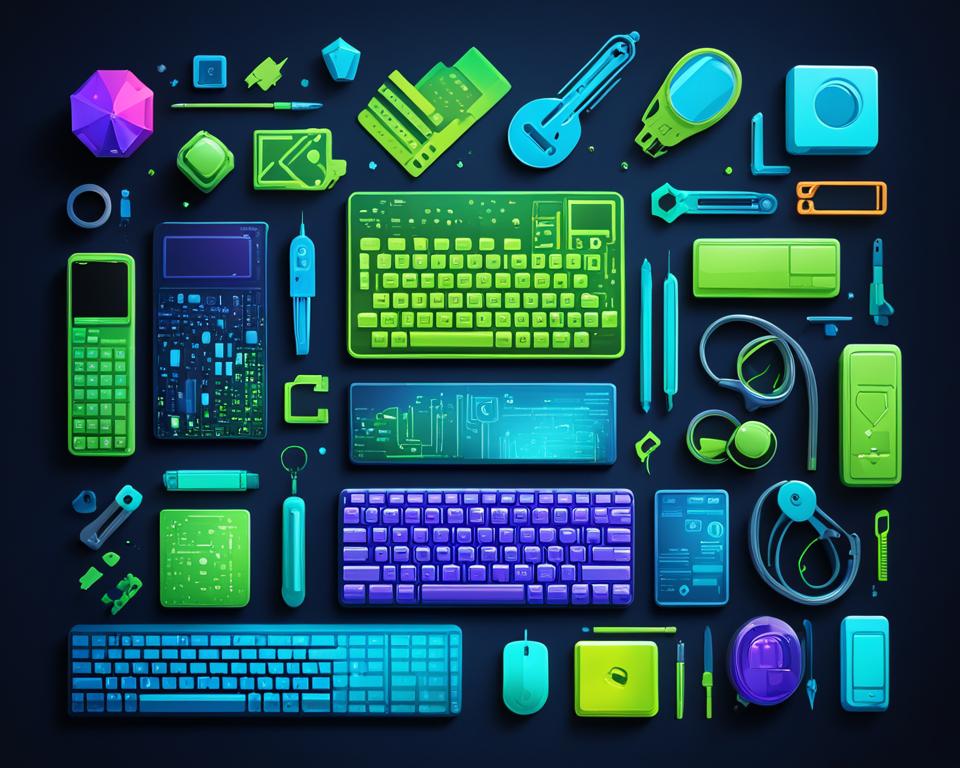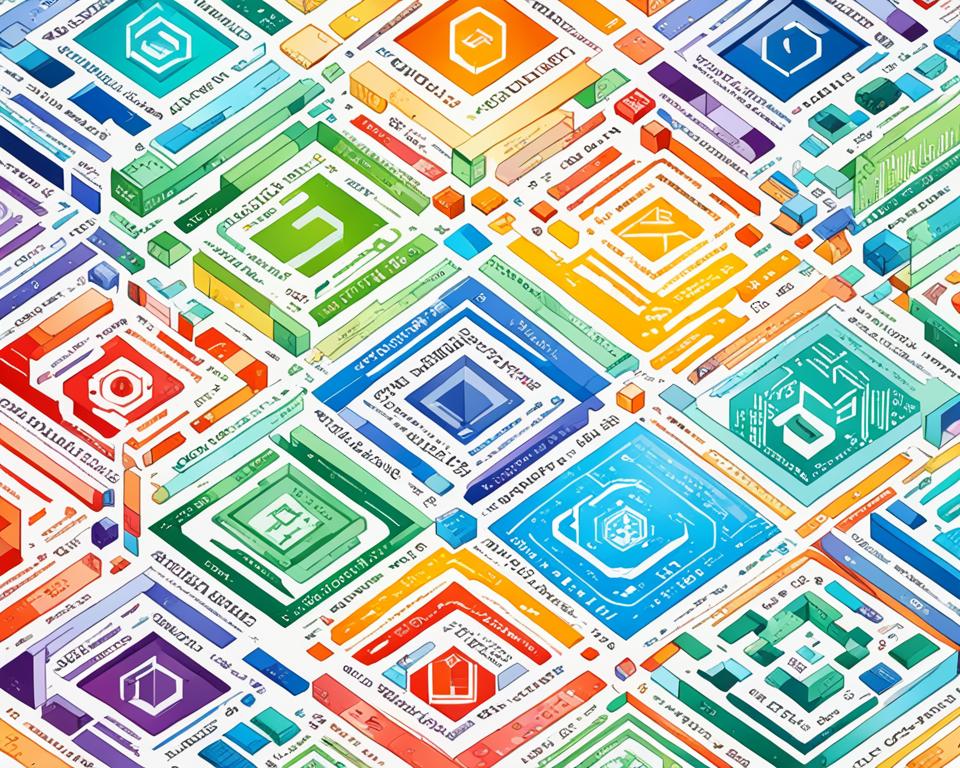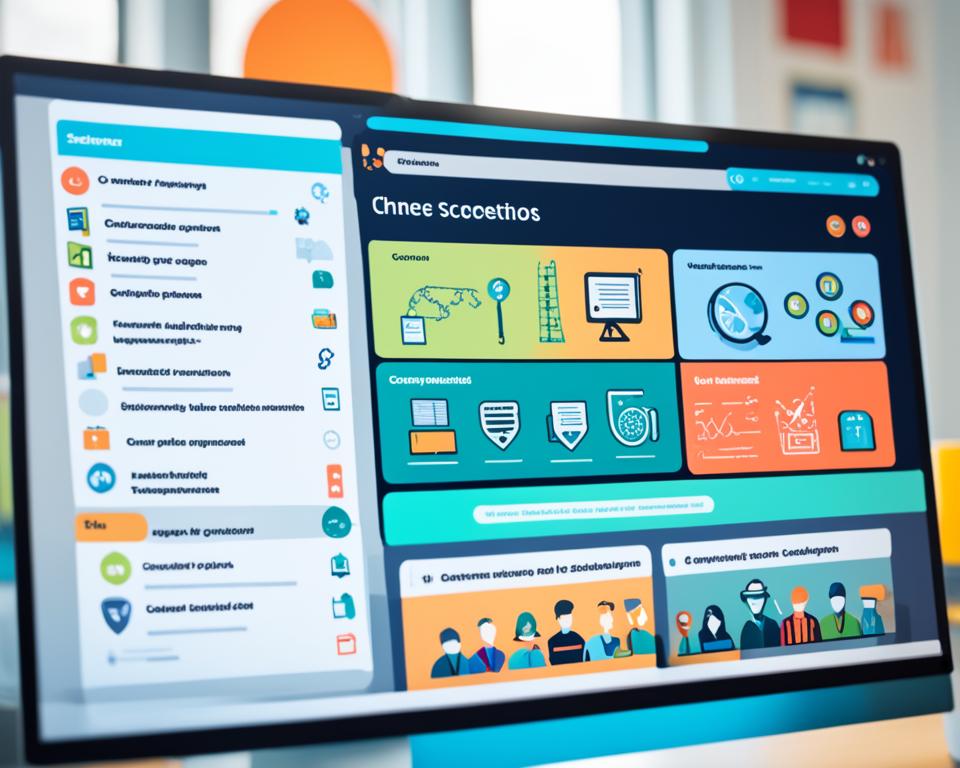Learning to code is an essential skill in the tech industry. Whether you are interested in pursuing a career in programming or simply want to enhance your problem-solving abilities, learning coding languages can open up a world of opportunities for you. With the increasing demand for skilled programmers, now is the perfect time to embark on your coding journey.
When it comes to coding languages, there are numerous options to choose from. From low-level languages that use binary code to high-level languages that are more user-friendly, each programming language has its own unique features and applications. Python, C, Ruby, Java, and JavaScript are some of the easiest programming languages to learn and are ideal for beginners.
Learning coding languages not only helps in developing technical skills but also enhances critical thinking and improves memory. By mastering coding languages, you will gain the ability to create software, build websites, and develop innovative applications.
Key Takeaways:
- Learning coding languages is crucial for career growth in the tech industry.
- Coding languages can enhance critical thinking and problem-solving abilities.
- Python, C, Ruby, Java, and JavaScript are some of the easiest programming languages to learn.
- Mastering coding languages allows you to create software and develop innovative applications.
- Embarking on your coding journey opens up numerous opportunities in the tech industry.
What is a Programming Language?
A programming language is a powerful tool that allows humans to communicate instructions to computers. It is a binary computer language consisting of symbols, strings, and queries that enable the computer to perform specific tasks. Programming languages are the backbone of software development and play a crucial role in shaping the digital world we live in today.
There are two main types of programming languages: low-level programming languages and high-level programming languages.
Low-Level Programming Languages
Low-level programming languages are machine-dependent and use binary code, which is a series of 0s and 1s understood by computers. These languages provide direct control over the hardware and resources of a computer system, allowing developers to write code that is highly optimized for performance. However, they require deep knowledge of computer architecture and are less user-friendly compared to high-level languages.
High-Level Programming Languages
High-level programming languages, on the other hand, are designed to be more user-friendly and efficient to write, read, and maintain. They provide a higher level of abstraction, allowing developers to focus on solving problems rather than dealing with intricate hardware details. High-level languages have simplified syntax and come with built-in functions and libraries that make it easier to write complex programs.
Some examples of popular high-level programming languages include Python, Java, C++, Ruby, and JavaScript. These languages have large and active communities that offer extensive documentation, resources, and support for beginners and experienced programmers alike.
In summary, a programming language is a binary computer language used to communicate instructions to computers. Low-level programming languages are machine-dependent and use binary code, while high-level programming languages are more user-friendly and efficient. Understanding the differences between these languages is crucial for aspiring programmers and individuals interested in the world of coding.
5 Easiest Programming Languages to Learn and Why
When embarking on your coding journey, it’s essential to choose a programming language that is easy to learn and has a supportive community. Here are five programming languages that fit the bill:
Python
Python is a high-level programming language known for its simplicity and readability. Its simple syntax makes it easy to learn, even for beginners. Python has an active community that offers extensive support and resources, making it a popular choice for new programmers. Additionally, Python’s open-source nature allows developers to access a wealth of libraries and frameworks, further enhancing its versatility.
C
C is a powerful and widely used programming language with a simple syntax. It has fewer keywords compared to other languages, making it easier to grasp. Additionally, C has a large online support community where beginners can find guidance and assistance. Learning C provides a solid foundation for understanding the fundamentals of programming.
Ruby
Ruby is renowned for its productivity and intuitive syntax. Its simplicity makes it an excellent language choice for beginners. Ruby’s focus on developer happiness and its clean syntax contribute to its appeal. There is a vast community of Ruby developers who actively contribute to its growth, which means ample resources and support are available for learners.
Java
Java is a popular and well-structured programming language that is widely used in the software development industry. It is an object-oriented language, meaning it emphasizes code organization and reuse. Java offers extensive resources for beginners, including comprehensive documentation and numerous learning materials. Its active community ensures ongoing support and continuous improvement.
JavaScript
JavaScript is a high-level interpreted language primarily used for web development. It has a simple and forgiving syntax that makes it accessible to beginners. One of JavaScript’s unique features is that it can be easily tested directly in a web browser. The JavaScript community is highly active, with a wealth of tutorials, forums, and libraries available to help you along your learning journey.
By choosing one of these easy-to-learn programming languages, you’ll be well on your way to developing the core skills needed to excel in the world of coding.
| Programming Language | Ease of Learning | Syntax Complexity | Active Community |
|---|---|---|---|
| Python | 🌟🌟🌟🌟🌟 | 🌟🌟 | 🌟🌟🌟🌟 |
| C | 🌟🌟🌟 | 🌟🌟 | 🌟🌟🌟 |
| Ruby | 🌟🌟🌟🌟 | 🌟🌟 | 🌟🌟🌟 |
| Java | 🌟🌟🌟 | 🌟🌟🌟 | 🌟🌟🌟 |
| JavaScript | 🌟🌟🌟 | 🌟🌟 | 🌟🌟🌟🌟 |
5 Hardest Programming Languages to Learn
Mastering programming languages can be quite challenging, especially when you dive into the realm of difficult and esoteric languages. Here are five programming languages that are known for their complexity and require a strong commitment to understand:
1. C++:
C++ is an extension of the C programming language and is widely used in systems programming and game development. Its complexity stems from its extensive libraries, low-level programming capabilities, and intricate syntax.

2. Prolog:
Prolog is a logic programming language that focuses on reasoning and searching for solutions. It requires near-perfect logic and a different way of thinking compared to other programming languages.
3. LISP:
As one of the oldest high-level programming languages, LISP utilizes extensive use of parentheses and is known for its unique syntax. Its functional nature and expressive power make it a language that requires dedication and perseverance to master.
4. Haskell:
Haskell is a purely functional programming language that emphasizes the importance of results. Its strong static typing, lazy evaluation, and advanced concepts can be daunting for beginners, but offer great rewards for those who invest the time.
5. Malbolge:
Malbolge is an esoteric programming language designed to be deliberately difficult. It was developed to challenge programmers with its complex rules and unconventional coding methods, making it one of the most cryptic and hard-to-understand languages in existence.
While these languages may be daunting, they also offer unique opportunities for exploration and growth for those willing to take on the challenge. Remember, the difficulty of a programming language should not discourage you, but rather inspire you to push your limits and expand your skills.
Table:
| Programming Language | Level of Difficulty |
|---|---|
| C++ | High |
| Prolog | High |
| LISP | High |
| Haskell | High |
| Malbolge | Extremely High |
How to Decide Which Programming Language to Learn
When it comes to choosing a programming language to learn, it’s important to consider your career goals and the specific domains that interest you. Different programming languages have their own strengths and applications, so aligning your choice with your desired career path can help you maximize job opportunities and achieve your professional goals.
For individuals interested in web design, CSS (Cascading Style Sheets) is an essential language to learn. CSS allows you to style the visual elements of a website and make it visually appealing. Mastering CSS can open doors to opportunities in web development and user interface design.
If your focus is on software development, two key languages to prioritize are JavaScript and React. JavaScript is the backbone of web development, enabling interactive elements and dynamic behavior on websites. React, a JavaScript library, is widely used for building user interfaces, making it a valuable skill for software development careers.
It’s also worth considering the breadth of resources available for beginners when choosing a programming language. Having access to comprehensive learning materials, tutorials, and helpful communities can greatly facilitate your journey. Look for languages with a vibrant and active community that provides support, documentation, and tutorials.
Furthermore, if you are learning coding as a hobby or simply want a versatile language, consider opting for a programming language that offers universality. Languages like Python and Java are widely used and applicable in various domains, offering flexibility and expansive job opportunities.
“The best way to predict the future is to create it.”
– Peter Drucker
Remember, choosing a programming language is an important decision that can shape your career opportunities and ultimately contribute to your success in the tech industry. Take the time to research and understand the different languages, explore their applications, and consider your personal aptitudes and aspirations when making your choice.
The Easiest Programming Language to Learn First
If you’re a coding beginner, Python is the perfect language to start your coding journey. It’s a beginner-friendly programming language that offers numerous advantages for new learners. With its simplified syntax and clear readability, Python makes it easier to understand and write code compared to other languages.
Python is an open-source language, which means it’s freely available for anyone to use and modify. This open-source nature encourages collaboration and innovation within the worldwide Python community, resulting in continuous improvements and updates to the language.
One of the key benefits of Python is its extensive community of developers. With a large and diverse community, it’s easy to find help, resources, and support when you encounter challenges while learning Python. Whether you need assistance with code troubleshooting or want to connect with like-minded individuals, the Python community is always there to lend a helping hand.
By choosing Python as your first programming language, you’re setting yourself up for success. Its beginner-friendly nature, simplified syntax, open-source availability, and worldwide community make it the ideal language for aspiring coders.
Why Python is the Easiest Language for Beginners
“Python is the perfect language for beginners due to its simplicity and readability. Its syntax is designed to be intuitive and easy to understand, making it accessible to new learners. With Python, you can focus on learning programming concepts without getting bogged down by complex syntax.”
Advantages of Python for Beginners
- Simple and intuitive syntax
- Fewer lines of code compared to other languages
- Open-source and freely available
- Active and supportive worldwide community
Learn Programming at Coding Dojo
Are you passionate about coding and ready to kickstart a career in the tech industry? Look no further than Coding Dojo, where you can gain the education and skills needed for success. With their coding bootcamps, Coding Dojo offers comprehensive training in various fields, including software engineering, software development, data science, cybersecurity, and UI/UX design.
At Coding Dojo, you’ll experience an intensive learning environment that prepares you for real-world coding projects and the demands of the industry. Their curriculum is carefully crafted to cover the essential concepts and technologies, ensuring you have a solid foundation to build upon. With hands-on projects and challenges, you’ll gain practical experience and develop problem-solving skills that employers value.
Whether you’re looking to switch careers or enhance your existing skillset, Coding Dojo provides the support and resources you need to thrive. Their instructors are industry professionals with in-depth knowledge and practical experience, ensuring you receive valuable insights and guidance throughout your coding journey.
Moreover, Coding Dojo’s bootcamps are designed to be accessible to aspiring developers of all backgrounds. You don’t need any prior coding experience to enroll. All you need is a passion for learning and a determination to succeed. Coding Dojo welcomes students from various age groups, educational backgrounds, and career paths, fostering a diverse and inclusive learning environment.
By joining Coding Dojo, you’ll have the opportunity to network with a community of like-minded individuals who share your passion for coding. Collaborate, share ideas, and learn from your peers, creating lasting connections that can boost your career prospects.
Ready to take the first step towards a rewarding career in tech? Visit the Coding Dojo website today to explore their coding bootcamps and embark on a transformative learning journey.
Learning to Code: Eight Steps to Master for Beginners
Embarking on your coding journey can be both exciting and challenging. Whether you’re interested in web development, software engineering, or data science, learning to code is a valuable skill that opens doors to a world of opportunities. To help you navigate this coding adventure, here are eight essential steps to master coding as a beginner:
- Understand the reasons for learning to code: Before diving into coding, reflect on why you want to learn. Are you seeking a career change, looking to expand your skillset, or simply exploring a new hobby? Understanding your motivations will provide clarity and drive throughout your coding journey.
- Choose the right coding tools and software: There is a wide range of coding tools available, each with its own features and advantages. Research and experiment with different Integrated Development Environments (IDEs) and text editors to find the one that suits your preferences and workflow.
- Pick the appropriate programming language: The choice of programming language depends on your goals and interests. Consider factors such as the language’s popularity, job market demand, and the resources available for learning. Start with a language that aligns with your objectives and provides a strong foundation for further learning.
- Start with coding fundamentals: Before tackling complex projects, grasp the fundamentals of coding. Learn concepts such as variables, loops, conditionals, and functions. Understanding these building blocks will make it easier to comprehend more advanced topics and concepts.
- Practice coding skills: Coding is not just about theory; it requires hands-on practice. Solve coding challenges, work on small projects, and explore coding exercises to reinforce your understanding and develop problem-solving abilities.
- Build projects: Building projects is an essential step in the learning process. Apply your newfound knowledge and skills to create your projects, whether it’s a simple website, a game, or a mobile app. Projects allow you to apply concepts in a practical way and showcase your abilities to potential employers.
- Share knowledge with others: Collaboration and sharing knowledge are vital aspects of the coding community. Engage with online forums, join coding meetups, and participate in open-source projects. Sharing ideas and helping others not only enhances your understanding but also fosters connections with like-minded individuals.
- Join the coding community: Immerse yourself in the coding community to stay updated with the latest trends, technologies, and best practices. Explore online coding communities, follow influential coders and organizations on social media, and attend coding conferences. The coding community provides support, inspiration, and networking opportunities.
Embarking on your coding journey can be a fulfilling and transformative experience. By following these eight steps, you’ll be well on your way to mastering coding fundamentals and building a solid foundation for future growth.
The Importance of Hands-On Learning
Learning to code is a hands-on endeavor. Theory alone is not enough to develop coding skills. Embrace practical coding exercises, projects, and challenges to build your confidence and problem-solving abilities.

Comparison of Popular Coding Tools
| Coding Tools | Features | Advantages |
|---|---|---|
| Visual Studio Code | Lightweight, highly customizable, extensive plugin ecosystem | Compatible with multiple programming languages |
| Atom | Free, open-source, beginner-friendly | Integration with Git for version control, large user community |
| PyCharm | Powerful debugging and code analysis, intelligent code completion | Designed specifically for Python development |
| Sublime Text | Lightning-fast, intuitive interface, multiple cursor support | Extremely customizable with a wide range of packages |
Remember, the choice of coding tools is subjective and depends on personal preferences and workflows. It’s recommended to try out different options and see which tools resonate with you the most.
Top Programming Languages for Data Science in 2020
Data science has become a crucial field in the age of big data, and choosing the right programming language is essential for success. In 2020, several programming languages have emerged as top choices for data scientists. Let’s explore the top programming languages for data science and their unique features:
- Python: Python is widely regarded as one of the best programming languages for data science. It offers a simple and intuitive syntax, making it easy to learn and write code. Python also has a vast ecosystem of libraries and frameworks, such as NumPy, Pandas, and TensorFlow, that facilitate various tasks in data manipulation, analysis, and machine learning. Its versatility and active community support make it a favorite among data scientists.
- R: R is another popular language in the field of data science, particularly for statistical analysis. It provides a wide range of packages, such as dplyr and ggplot2, that enable powerful data manipulation and visualization. R’s statistical capabilities and extensive library support make it a preferred choice for researchers and analysts working with complex datasets.
- SQL: SQL, or Structured Query Language, is essential for working with databases. It allows data scientists to retrieve, manipulate, and analyze data stored in relational databases efficiently. SQL is widely used in data science projects that involve data extraction, transformation, and loading (ETL) processes. Knowledge of SQL is crucial for data scientists working with large datasets and complex data queries.
- Java: Java is a versatile programming language that has been widely adopted in various industries, including data science. It offers flexibility and scalability and is commonly used for building enterprise-level applications. While not specifically designed for data science, Java’s robustness and extensive ecosystem make it a preferred language for developing data-intensive applications.
- Julia: Julia is a relatively new programming language that has gained popularity in the data science community. It is designed for high-performance computing and combines the ease of use of languages like Python and R with the speed of low-level languages like C++. Julia’s efficient execution and its ability to handle large datasets and complex numerical computations make it an excellent choice for data scientists working on computationally intensive tasks.
Choosing the right programming language for data science depends on various factors, including project requirements, personal preferences, and the specific tasks at hand. Python and R are widely considered to be the top languages for beginners in data science due to their simplicity and extensive community support. SQL is crucial for working with databases, while Java and Julia offer unique advantages in terms of scalability and high-performance computing.
The table below provides an overview of the top programming languages for data science, highlighting their key features and applications:
| Programming Language | Features | Applications |
|---|---|---|
| Python | Simple syntax, extensive libraries | Data manipulation, analysis, machine learning |
| R | Statistical capabilities, vast package ecosystem | Statistical analysis, data visualization |
| SQL | Efficient data retrieval, manipulation, and analysis | Database querying, ETL processes |
| Java | Flexibility, scalability, enterprise-level applications | Data-intensive application development |
| Julia | High-performance computing, ease of use | Computationally intensive tasks |
As data science continues to evolve, staying updated with these top programming languages and their advancements will be crucial for aspiring and experienced data scientists alike. Choosing the right language can greatly enhance productivity and enable data scientists to unlock valuable insights from complex datasets.
10 of the Weirdest Tech Inventions in the World
Human innovation knows no bounds, and the world of technology is no exception. From the downright bizarre to the strangely intriguing, here are ten of the weirdest tech inventions that will leave you scratching your head:
- A robot that can fold laundry: Say goodbye to tedious folding sessions with this high-tech invention. Powered by artificial intelligence, this robot uses advanced algorithms to neatly fold your laundry, saving you time and effort.
- A smart toilet that analyzes waste: Forget everything you thought you knew about toilets. This cutting-edge invention is equipped with sensors that analyze your waste, providing you with valuable health data and insights.
- A toaster that burns selfies onto bread: Start your day with a personalized piece of toast! This quirky toaster connects to your smartphone and burns images onto your bread, allowing you to enjoy a selfie or any other design.
- A Bluetooth-enabled smart fork that monitors eating habits: Have you ever wondered how fast you eat or if you’re eating too much? This innovative smart fork detects your eating habits, helping you maintain a healthier and more mindful approach to meals.
- A wearable air-conditioned jacket: Stay cool wherever you go with this unusual invention. This jacket uses integrated fans and innovative cooling technology, keeping you comfortable even in the hottest of environments.
- A selfie drone: Take your selfies to new heights with a drone dedicated solely to capturing your best angles. This miniature flying device hovers in the air, ensuring you get the perfect shot from any vantage point.
- An automated pet feeder: Never miss a meal for your furry friend with this automated pet feeder. It dispenses food at predetermined intervals, ensuring your pet stays nourished even when you’re not at home.
- A smart hairbrush: Yes, even hairbrushes have gone high-tech. This intelligent hairbrush uses sensors to analyze your hair quality, giving you personalized tips and recommendations for better hair care.
- A laser keyboard: Ditch the conventional keyboard for this futuristic invention. By projecting a laser-generated keyboard onto any flat surface, you can type away with ease, wherever and whenever.
- A mind-reading helmet: Unlock the potential of your thoughts with this mind-reading helmet. Using neuroimaging technology, this peculiar invention translates your brainwaves into commands, offering a glimpse into the future of human-computer interaction.
These quirky inventions highlight the incredible creativity and boundless imagination of human beings. From robots that fold laundry to toilets that analyze waste, the world of technology continues to surprise us with its unconventional and unusual innovations.
Conclusion
Learning coding languages is crucial in today’s tech industry. It not only provides numerous career opportunities but also enhances critical thinking and problem-solving abilities. By following a structured learning path, practicing coding, and building projects, you can master programming skills.
Joining coding bootcamps and engaging with the coding community can greatly accelerate your learning process. These experiences allow you to learn from industry professionals, collaborate with like-minded individuals, and gain valuable insights into the best practices in programming.
With dedication and perseverance, you can unlock the full potential of learning coding languages and boost your programming skills. Whether you aspire to become a software engineer, data scientist, or web developer, proficiency in coding will undoubtedly open doors to exciting opportunities in the tech industry.
FAQ
What is a programming language?
A programming language is a binary computer language that uses symbols, strings, and queries to communicate instructions to the computer. There are low-level programming languages that are machine-dependent and use binary code, and high-level programming languages that are more user-friendly and efficient to write, read, and maintain.
What are the easiest programming languages to learn?
Python, C, Ruby, Java, and JavaScript are some of the easiest programming languages to learn. Python has a simple syntax, open-source nature, and an active community. C has a simple syntax with fewer keywords and a large online support community. Ruby is designed for productivity and fun with a similar syntax. Java is well-structured and object-oriented, with a wide range of resources for beginners. JavaScript is a high-level interpreted language that can be easily tested in a web browser.
What are the hardest programming languages to learn?
Some of the hardest programming languages to learn include C++, Prolog, LISP, Haskell, and Malbolge. C++ can be complex due to its system. Prolog is a logic programming language that requires near-perfect logic. LISP, one of the oldest high-level coding languages, uses parentheses extensively. Haskell is a purely functional programming language with a focus on results. Malbolge is an esoteric programming language designed to be intentionally difficult.
How do I decide which programming language to learn?
When deciding which programming language to learn, consider your career goals. For web design, CSS is important, while JavaScript and React are essential for software development. Look for languages with a wide range of resources for beginners and universality if you are learning coding as a hobby.
What is the easiest programming language to learn first?
Python is the best language for beginners to start their coding journey. It has a simplified syntax, fewer lines of code compared to other languages, and is open-source. Python also has a large community of developers, making it easy to find help and resources.
How can I learn programming at Coding Dojo?
Coding Dojo offers coding bootcamps that provide education and skills for a career in software engineering, development, data science, cybersecurity, and UI/UX design. Their courses are intensive and prepare students for real-world coding projects and careers in the tech industry.
What are the eight steps to master coding as a beginner?
The eight steps to master coding as a beginner include understanding the reasons for learning to code, choosing the right coding tools and software, picking the appropriate programming language, starting with coding fundamentals, practicing coding skills, building projects, sharing knowledge with others, and joining the coding community.
What are the top programming languages for data science in 2020?
Python, R, SQL, Java, and Julia are some of the top programming languages used in data science. Python is widely used for its simplicity and extensive libraries, and R is popular for statistical analysis. SQL is essential for working with databases, Java is used for enterprise-level applications, and Julia is gaining popularity for its high-performance computing capabilities.
What are some of the weirdest tech inventions in the world?
There are many strange and bizarre tech inventions in the world, such as a robot that can fold laundry, a smart toilet that analyzes waste, a toaster that can burn selfies onto bread, and a Bluetooth-enabled smart fork that monitors eating habits. These inventions showcase the creativity and quirkiness of human innovation.





